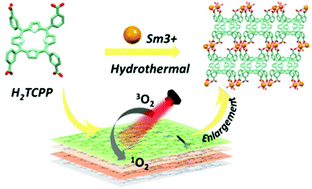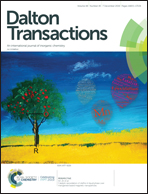A small-sized and stable 2D metal–organic framework: a functional nanoplatform for effective photodynamic therapy†
Abstract
The efficiency of photosensitizers in tumor photodynamic therapy (PDT) often compromises their poor water solubility, low extinction coefficients, photobleaching, and dissatisfactory reactive oxygen species (ROS) generation efficiency. Herein, a nanoscale 2D metal–organic framework, Sm-H2TCPP nanosheets, was first synthesized by Sm3+-driven coordination with a porphyrin derivative (tetrakis(4-carboxyphenyl)porphyrin (H2TCPP)) for highly effective PDT of breast cancer. The prepared Sm-H2TCPP possessed nanoplate morphology with ultrathin thickness at the sub-10 nm level and an ultrasmall plane size at the sub-100 nm level. Compared with free H2TCPP, the prominent ROS generation capacity of the well-defined Sm-H2TCPP nanosheets is mainly attributed to their improved physicochemical properties and the enhanced intersystem crossing caused by heavy Sm nodes. The significantly improved PDT efficacy of the Sm-H2TCPP nanosheets was further investigated in vitro and in vivo based on the MCF-7 breast cancer model. It is envisaged that the Sm-H2TCPP nanosheets will offer a new avenue for the development of a new class of potential PDT agents.



 Please wait while we load your content...
Please wait while we load your content...